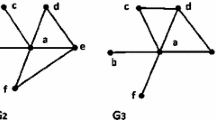Abstract
This paper addresses the issue of measuring temporal dynamics of complex socio-economic relational systems, represented as time-dependent networks. Network dynamics is first splitted into a structural component, accounting for changes in the network topology, and a non-structural component, accounting for permutation of vertex labels. A quantitative measure of the dynamics and its components is then proposed and it is shown how it can be used to investigate and interpret the time evolution of networks. A real example is discussed, pertaining to the dynamics of a subnetwork of the Italian corporate board network.






Similar content being viewed by others
Notes
For sake of simplicity, in the following elements of \(X\) partially ordered by \(\le \) will be referred directly as elements of \(P\).
A chain between two nodes \(a\) and \(b\) is called maximal if it is not properly contained in any other chain connecting the two nodes.
The length of a chain is the number of elements of the chain minus 1.
We stress that the proof of the lemma depends upon the properties of the selected metric and the topology of \(\mathbb G _n\) (which, as already stated, has the structure of a lattice of subsets) and that it does not hold for arbitrary metrics and arbitrary lattices.
\(G^{*}\) is turned into \(G_{2}\) permuting vertices \(a\) and \(d\).
Company names are coded as follows: a—Buzzi Unicem; b—Camfin; c—Cobra Automotive Technologies; d—Credito Artigiano; e—Fastweb; f—Fondiaria Sai; g—Saras; h— L’Espresso; i—Indesit; j—Seat Pagine Gialle.
References
Axenovich, M., Kézdy, A., Martin, R.: On the editing distance of graphs. J. Graph. Theory 58(2), 123–138 (2008)
Barabasi, A., Oltvai, Z.N.: Network biology: understanding the cell’s functional organization. Nat. Rev. Genet. 5, 101–114 (2004)
Battiston, S., Catanzaro, M.: Statistical properties of board and director networks. Eur. Phys. J. B 38, 345–352 (2004)
Braha, D., Bar-Yam, Y.: From centrality to temporary fame: dynamic centrality in complex networks. Complexity 12(2), 59–63 (2006)
Caldarelli, G., Catanzaro, M.: The corporate boards networks. Phys. A 338, 98–106 (2004)
Davey, B.A., Priestley, B.H.: Introduction to lattices and order. CUP, Cambridge (2002)
Garlaschelli, D., Battiston, S., Castri, M., Servedio, V.D.P., Caldarelli, G.: The scale-free topology of market investments. Phys. A 350(2–4), 491–499 (2005)
Gao, X., Xiao, B., Tao, D., Li, X.: A survey of graph edit distance. Pattern Anal. Appl. 13, 113–129 (2010)
Harary, F.: Graph theory. Perseus Books, Cambridge (1969)
Koenig, M.D., Tessone, C.J.: Network evolution based on centrality. Phys. Rev. E 84(5), 056108-1–056108-6 (2011)
Latora, V., Marchiori, M.: A measure of centrality based on network efficiency. New J. Phys. 9, 188 (2007)
Mizruchi, M.S.: What do interlocks do? An analysis, critique, and assessment of research on interlocking directorates. Ann. Rev. Sociol. 22, 271–298 (1996)
Reka, A., Barabasi, A.: Statistical mechanics of complex networks. Rev. Mod. Phys. 74, 47–97 (2002)
Sanfeliu, A., Fu, K.-S.: Distance measure between attributed relational graphs for pattern recognition. IEEE Trans. Syst. Man Cybern. 13(3), 353–362 (1983)
Wasserman, S., Faust, K.: Social network analysis: methods and applications. CUP, Cambridge (1994)
Zeng, Z., Tung, A.K.H., Wang, J., Feng, J., Zhou, L.: Comparing stars: on approximating graph edit distance. Proc. VLDB Endow. 2(1), 25–36 (2009)
Author information
Authors and Affiliations
Corresponding author
Rights and permissions
About this article
Cite this article
Fattore, M., Grassi, R. Measuring dynamics and structural change of time-dependent socio-economic networks. Qual Quant 48, 1821–1834 (2014). https://doi.org/10.1007/s11135-013-9861-1
Published:
Issue Date:
DOI: https://doi.org/10.1007/s11135-013-9861-1




